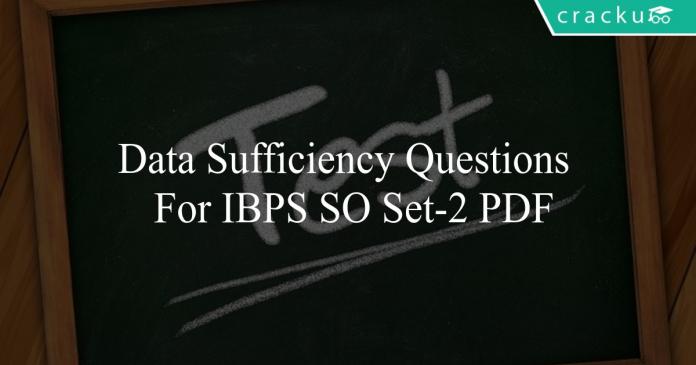Download Data Sufficiency Questions For IBPS SO Set-2 PDF
Instructions
Directions: Each of the questions below consists of a question and two statements numbered I and II given below it. You have to decide whether the data given in the statements are sufficient to answer the questions.
a) The data in statement I alone are sufficient to answer the question, while the data in statement II alone are not sufficient to answer the question.
b) The data in statement II alone are sufficient to answer the question, while the data in statement I alone are not sufficient to answer the question.
c) The data either in statement I alone or statement II alone are sufficient to answer the question.
d) The data in statement I and II together are not sufficient to answer the question.
e) The data in both statements I and II together are necessary to answer the question.
Question 1: Seventeen people are standing in a straight line facing south. What is Bhavna’s position from the left end of the line?
I. Sandeep is standing second to the left of Sheetal. Only five people stand between Sheetal and the one who is standing at the extreme right end of the line. Four people stand between Sandeep and Bhavna.
II. Anita is standing fourth to the left of Sheetal. Less than three people are standing between Bhavna and Anita.
a) The data in statement I alone are sufficient to answer the question, while the data in statement II alone are not sufficient to answer the question.
b) The data in statement II alone are sufficient to answer the question, while the data in statement I alone are not sufficient to answer the question.
c) The data either in statement I alone or statement II alone are sufficient to answer the question.
d) The data in statement I and II together are not sufficient to answer the question.
e) The data in both statements I and II together are necessary to answer the question.
Question 2: Five letters – A, E, G, N and R – are arranged from left to right according to certain conditions. Which letter is placed third?
I. G is placed second to the right of A. E is on the immediate right of G. There are only two letters between R and G.
II. N is exactly between A and G. Neither A nor G is at the extreme and of the arrangement.
a) The data in statement I alone are sufficient to answer the question, while the data in statement II alone are not sufficient to answer the question.
b) The data in statement II alone are sufficient to answer the question, while the data in statement I alone are not sufficient to answer the question.
c) The data either in statement I alone or statement II alone are sufficient to answer the question.
d) The data in statement I and II together are not sufficient to answer the question.
e) The data in both statements I and II together are necessary to answer the question.
Question 3: Six people – S, T, U, V, W and X – are sitting around a circular table facing the centre. What is T’s position with respect to X?
I. Only two people sit between U and W. X is second to the left of W. V and T are immediate neighbours of each other.
II. T is to the immediate right of V. There are only two people between T and S. X is an immediate neighbour of S but not of V.
a) The data in statement I alone are sufficient to answer the question, while the data in statement II alone are not sufficient to answer the question.
b) The data in statement II alone are sufficient to answer the question, while the data in statement I alone are not sufficient to answer the question.
c) The data either in statement I alone or statement II alone are sufficient to answer the question.
d) The data in statement I and II together are not sufficient to answer the question.
e) The data in both statements I and II together are necessary to answer the question.
Free Banking Study Material – 15000 Solved Questions
InstructionsInstructions: Each of the following questions consists of a question followed by three statements I, II and III. You have to study the question and the statements and decide which of the statement (s) is/are necessary to answer the question.
Question 4: What is the speed of boat in still water?
I. The boat covers 12 km in 2 hours in downstream.
II. The boat covers same distance in 4 hours in upstream.
III. The speed of stream is one third of that of boat in still water.
a) Both I and II
b) I and either II or III
c) All I, II and III
d) Question cannot be answered even with the information in all three statements
e) None of these
Question 5: What is the speed of train?
I. The length of train is 240 metre.
II. The train crosses a pole in 24 seconds.
III. The train crosses a platform in 48 seconds.
a) Both I and III
b) Both I and II
c) Both II and III
d) Any two of three
e) None of these
Question 6: How many meaningful English words can be formed with the letters ENCO, using each letter only once in each word?
a) None
b) One
c) Two
d) Three
e) More than three
InstructionsInstructions: Each of the following questions consists of a question followed by three statements I, II and III. You have to study the question and the statements and decide which of the statement (s) is/are necessary to answer the question.
Question 7: Sri Gupta borrowed a sum at compound interest. What is the amount returned in 2 years?
I. The rate of interest is 5% per annum.
II. The simple interest incurred on the sum in 1 year is Rs600.
III. The borrowed sum is ten times the amount earned as simple interest in two years.
a) Only I
b) Only III
c) Both II and III
d) Either I or III
e) All I, II and III
Question 8: What is the area of the given right angled triangle?
I. The length of hypotenuse is 5 cm.
II. The perimeter of triangle is four times of its base.
III. One of the angles of triangle is 60°
a) Only II
b) Only III
c) Either II or III
d) Both I and III
e) Question cannot be answer even with the information in all three statements
InstructionsDirections : Each of the questions below consists of a question and three statements numbered I, II and III given below it. You have to decide whether the data provided in the statements are sufficient to answer the question.
Question 9: How many daughters does W have?
I. B and D are the sisters of M.
II. M’s father T is the husband of W.
III. Out of the three children which T has, only one is a boy.
a) Only I and III are sufficient to answer the question.
b) All I, II and III are required to answer the question.
c) Only II and III are sufficient to answer the question.
d) Question cannot be answered even with all I, II and III
e) Only I and II are sufficient to answer the question.
Question 10: Who among A, B, C, D, E and F, each having a different height, is the tallest?
I. .B is taller than A but shorter than E.
II. Only two of them are shorter than C.
III.. D is taller than only F.
a) Only I and II are sufficient to answer the question.
b) Only I and III are sufficient to answer the question.
c) Only II and III are sufficient to answer the question.
d) All I, II and III are required to answer the question.
e) All I, II and III even together are not sufficient to answer the question.
Question 11: Towards which direction is Village J from Village W?
I. Village R is to the west of Village W and to the north of Village T.
II. Village Z is to the east of Village J and to the south of Village T.
III. Village M is to the north-east of Village J and to the north of Village Z.
a) Only III is sufficient to answer the question.
b) Only II and III sufficient to answer the question.
c) All I, II and III are required to answer the question.
d) Question cannot be answered even with all I, II and III.
e) None of these
Question 12: On which day of the week did Suresh visit Chennai? (Assume that the week starts from Monday.)
I. Suresh took a leave on Wednesday.
II. Suresh visited Chennai the day after his mother’s visit to his house.
III. Suresh’s mother visited his house on neither Monday nor Thursday.
a) Only II and III are sufficient to answer the question.
b) Only I and II are sufficient to answer the question.
c) Only I and III are sufficient to answer the question.
d) All I, II and III are required to answer the question.
e) Question cannot be answered even with all I, II and III.
200+ Banking Previous Papers (Download PDF)
Question 13: How is ‘go’ written in a code language?
I. ‘now or never again’ is written as ‘torn ka na sa’ in that code language.
II.’you come again now’ is written as ‘ja ka ta sa’ in that code language.
III. ‘again go now or never’ is written as ‘na ha ka sa torn’ in that code language.
a) Only I and III are sufficient to answer the question.
b) Only II and III are sufficient to answer the question.
c) Only I and II are sufficient to answer the question.
d) All I, II and III are required to answer the question.
e) None of these
InstructionsDirections : Each of the questions below consists of a question and three statements numbered I, II and III given below it. You have to decide whether the data provided in the statements are sufficient to answer the question. Read all the three statements and give answer-
Question 14: Among six people P, Q, R, S, T and V each lives on a different floor of a six-storey building having six floors numbered one to six (the ground floor is numbered 1, the floor above it, number 2 and so on and the topmost floor is numbered 6. Who lives on the topmost floor? I) There is only one floor between the floors on which R and Q live. P lives on an even numbered floor.
II) T does not live on an even numbered floor. Q lives on an even numbered floor. Q does not live on the topmost floor.
III) S lives on an odd numbered floor. There are two floors between the floors on which S and P live. T lives on a floor immediately above R’s floor.
a) If the data in Statement I and II are sufficient to answer the question, while the data in Statement III are not required to answer the question.
b) If the data in Statement I and III are sufficient to answer the question, while the data in Statement II are not required to answer the question.
c) If the data in Statement II and III are sufficient to answer the question, while the data in Statement I are not required to answer the question.
d) If the data in either Statement I alone or Statement II alone or Statement III alone are sufficient to answer the question.
e) If the data in all the Statements I, II and III together are necessary to answer the question.
Question 15: There are six letters W, A, R, S, N and E. Is “ANSWER” the word formed after performing the following operations using these six letters only?
I) E is placed fourth to the right of A. S is not placed immediately next to either A or E.
II) R is placed immediately next (either left or right) to E. W is placed immediately next (either left or right) to S.
III) Both N and W are placed immediately next to S. The word does not begin with R. A is not placed immediately next to W.
a) If the data in Statement I and II are sufficient to answer the question, while the data in Statement III are not required to answer the question.
b) If the data in Statement I and III are sufficient to answer the question, while the data in Statement II are not required to answer the question.
c) If the data in Statement II and III are sufficient to answer the question, while the data in Statement I are not required to answer the question.
d) If the data in either Statement I alone or Statement II alone or Statement III alone are sufficient to answer the question.
e) If the data in all the Statements I, II and III together are necessary to answer the question.
Free Banking Study Material (15000 Solved Questions)
Answers & Solutions:
1) Answer (E)
From statement 1 or statement 2 alone, we cannot determine the position of Bhavna.
Using both the statements,
_ _ _ _ _ _ Sheetal _ Sandeep _ Anita _ _ Bhavna …
So, Bhavna’s position can be determined using both the statements together.
2) Answer (C)
From statement 1 alone: R A N G E is the only possibility
From statement 2 alone: R/E A/G N G/A E/R is the possibility. So, the middle letter can be determined.
So, the question can be answered by using either statement alone.
3) Answer (B)
From statement 1, the positions are as follows:

From statement 2, the positions are as follows:

So, the question can be answered by using statement 2 alone, but not by using statement 1 alone.
4) Answer (B)
Downstream = boat + stream = $\frac{12}{2}$ + stream = 6 km/hr
Upstream =boat – stream = $\frac{12}{4}$ – stream = 3 km/hr
Solving the above equations we get boat = 4.5 km/hr and stream = 6 – 4.5 = 1.5
Speed of the stream = $\frac{1}{3}$rd of that of the boat in still river = 1.5
5) Answer (B)
Length of the train = 240 m
Time taken to cross the pole = 24 seconds
Speed = $\frac{240}{24}$ = 10 m/s
6) Answer (C)
There are only two meaningful words that can be formed from the four alphabets and they are CONE, ONCE
7) Answer (C)
SI in 1 year = 600
for two years = 1200
Sum = 10 x 1200 = 12000
600 = 12000*r*1/100
r = 5%
Amount returned in two years = 12000(1 + $\frac{5}{100}$)2 = 13230
8) Answer (D)
Length of the hypotenuse = 5 cm
Other two sides = 4cm ,3 cm (pythaogrean triples)
Area = $\frac{1}{2}$ x base x height = $\frac{1}{2}$ x 3 x 4 = 6cm2
9) Answer (C)
Options 2 and 3 provide all the information needed to answer the question.
10) Answer (D)
Using statement I alone: E > B > A
Using statement II alone: C’s rank is 3.
Using statement III alone: D’s rank is 5 and F’s rank is 6.
Using any two of the three statements, we cannot answer the question.
Using all three statements, C = 3rd rank, D = 5th rank, F = 6th rank; E = 1st rank, B = 2nd rank and A = 4th rank
11) Answer (E)
Statetments 1 and 2 are sufficient to answer the question. Hence option 5 is correct as none of the options indicate this.
12) Answer (E)
Suresh took leave on Wednesday doesn’t mean he visited Chennai on that day. Since Suresh’s mother visited him on neither Monday nor Thursday, she could have visited on Tuesday, Wednesday, Friday, Saturday or Sunday. It is given that Suresh visited Chennai the day after his mother’s visit. Since the exact day on which Suresh’s mother visited his house cannot be determined, the day on which Suresh visited Chennai cannot be determined. Thus, we cannot determine the answer exactly even by using all three statements.
13) Answer (A)
From statements I and III, we can determine the code for ‘go’ as ‘ha’. So, I and III are sufficient to answer the question.
14) Answer (E)
Based on information in the paragraph, the person in the highest floor lives on 6 (even number). P, Q and R live in even numbered floors. T lives above R =. So, R is not the answer. Q is not in the top floor. So, P is in the top floor. Information from all three statements is used to arrive at this solution.
15) Answer (B)
Consider statements I and III:
The possibilities with the information given in statement I are A _ S _ E _ and _ A _ S _ E.
Using statement III, the only possibility is A N S W E R.
So, option b) is the correct answer.





